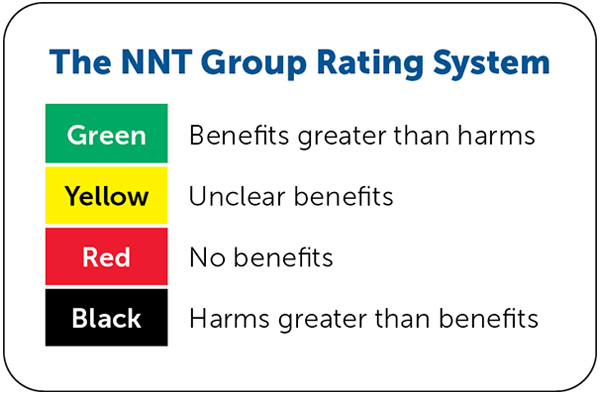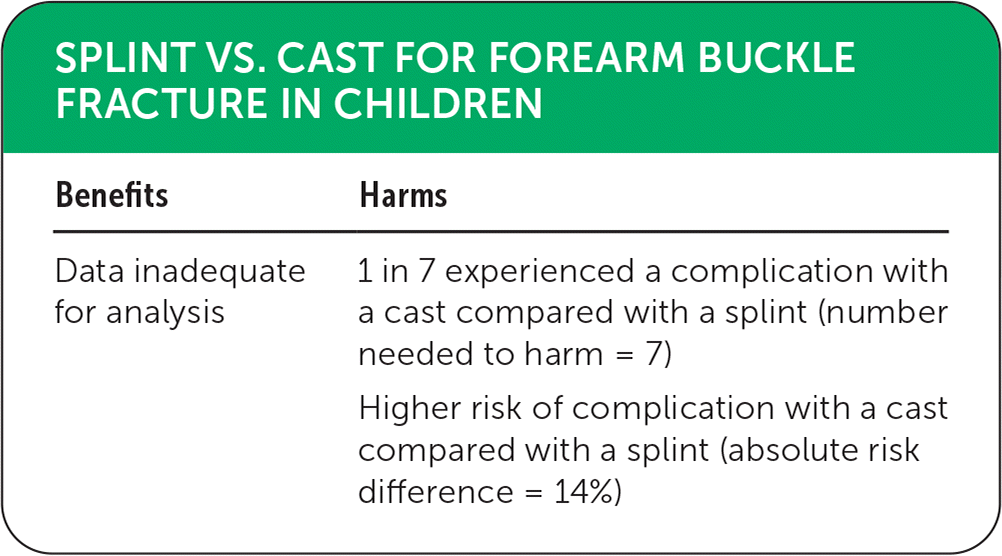
Am Fam Physician. 2022;105(4):online
Author disclosure: No relevant financial relationships.


| Benefits | Harms |
|---|---|
| Data inadequate for analysis | 1 in 7 experienced a complication with a cast compared with a splint (number needed to harm = 7) |
| Higher risk of complication with a cast compared with a splint (absolute risk difference = 14%) |
Details for This Review
Study Population: Children (two to 16 years of age) with confirmed forearm buckle fractures
Efficacy End Points: Functional recovery and patient satisfaction
Harm End Points: Complications, defined as refracture, cast heaviness, cast tightness, and cast-related return visits
Narrative: Wrist fractures involving the distal radius are the most common fractures in children.1 A buckle (i.e., torus) fracture in children usually occurs at the distal metaphysis where the bone is less dense. This injury is caused by buckling, or folding, of the cortex (the outer layer and thicker section of the bone) due to compression. Buckle fractures are stable, and treatment is intended to relieve pain and discomfort and protect the bone from further injury.2 There is debate about optimal fracture treatment using rigid casts or nonrigid methods (e.g., splints). The systematic review and meta-analysis summarized here compares the clinical effectiveness of nonrigid vs. rigid methods for forearm buckle fractures in children.3
The meta-analysis included data from randomized controlled trials that enrolled children two to 16 years of age with forearm buckle fractures confirmed by ultrasonography or radiography. Main outcomes included recovery of physical and social functions (e.g., bathing, writing, drawing, grooming), complications, and patient satisfaction. The analysis included eight relevant randomized controlled trials with 781 total patients.3
The systematic review reported pooled outcomes of complications occurring in patients treated with casts and splints. Data from three of the eight studies included in the systematic review were pooled because they were the only trials that reported complications. The meta-analysis found that patients undergoing cast immobilization experienced more complications than those immobilized by splint or other nonrigid methods (relative risk = 3.02; 95% CI, 1.70 to 5.37; absolute risk difference = 14%; number needed to harm = 7). Complications mentioned in the trials included refracture, cast heaviness, cast tightness, and return to the emergency department due to cast-related damage.3
The systematic review could not combine data for outcomes regarding functional recovery or patient satisfaction because of the paucity of data from trials. Through these studies, the authors of the systematic review reported that patients treated with nonrigid methods had better recovery of wrist motion, quicker return to normal activity, and less overall disability. It was unclear which intervention resulted in a shorter duration of pain. The authors also concluded that patients and their parents were more comfortable with nonrigid immobilization and would choose splints over casts in the future. However, these findings are based on single small trials.3
Caveats: The 2016 guidelines from the National Institute for Health and Care Excellence recommend against using casts for the treatment of buckle fractures.4 The Pediatric Orthopaedic Society of North America also recommends using a prefabricated wrist splint instead of a cast to treat buckle fractures in children, who have immature skeletons, because splinting is preferred by parents and patients, is less expensive than casting, and simplifies treatment.5 Some studies go further and suggest that any minimally displaced distal radius or ulnar fracture (no more than 15 degrees of angulation) can be managed by splinting alone.6
Conclusion: The existing but limited evidence supports the use of nonrigid immobilization techniques for the treatment of buckle fractures in children. Although the evidence is lacking on which method is superior in the long-term, the nonrigid method is associated with fewer complications and probably offers more comfort and higher patient satisfaction. We have assigned a color recommendation of green (benefits greater than harms) for using nonrigid immobilization techniques for the treatment of buckle fractures in children.
